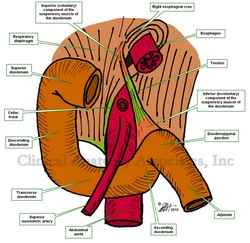
Click on the image for a larger version
The duodenojejunal junction is the point where the fourth segment of the duodenum, the ascending duodenum, meets and is continuous with the most proximal portion of the jejunum.
The suspensory muscle of the duodenum attaches to the superior aspect of the duodenojejunal junction. This muscle is also known as the "muscle of Treitz" or "musculus suspensorius duodenii" and was first described in 1853 by Dr. Václav Treitz. The parietal peritoneum forms a fold over the suspensory muscle of the duodenum and this fold is known as the "ligament of Treitz".
The duodenojejunal junction (marked by the ligament of Treitz) is an important anatomical landmark used by anatomists and surgeons to denote the point where the small intestine passes from retroperitoneal duodenum to intraperitoneal jenunum. This means that while most of the duodenum is covered by parietal peritoneum, plastered to the posterior abdominal wall, and immobilized by it; the jejunum is mobile, meaning that the anatomist and surgeon can easily move it around because of the presence of a well-developed mesentery.
Sources:
1. "Clinically Oriented Anatomy" Moore, KL. 3r Ed. Williams & Wilkins 1992
2. "The origin of Medical Terms" Skinner, AH, 1970
3. "The suspensory muscle of the duodenum and its nerve supply" Jit, I.; Singh, S. J. Anat. (1977), 123, 2, pp. 397-405
4. "Anatomical and functional aspects of the human suspensory muscle of the duodenum." Costacurta, L. Acta Anat (Basel). 1972;82(1):34-46
Image property of: CAA.Inc. Artists: Dr. E. Miranda and D.M. Klein



